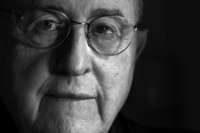
In December 1985, a movement of doctors committed to overcoming Cold War divisions in the interest of peace, International Physicians for the Prevention of Nuclear War (IPPNW) was awarded the Nobel Peace Prize. As doctors, they argued, they had the duty to confront the grave threat to human life posed by impending nuclear war. The movement’s co-presidents, Yevgeny Chazov from the Soviet Union and Bernard Lown from the United States, accepted the Peace Prize on behalf of the movement. In his Nobel address that evening, entitled “A Prescription for Hope,” Lown said, “Only those who see the invisible can do the impossible.” This apparently irresolvable affirmation captures the idealism and realism of Lown’s activist message. It conveys the challenge that his life poses to the rest of us. Lown died on February 16 at the age of 99.
Bernard Lown was a person of the 20th century. When he was a youth in the 1930s, his family emigrated from Lithuania to Maine as antisemitism and Nazism took hold of Europe. Many of his relatives did not survive the onslaught of fascism. The political, technological and human horrors of modern genocide were thus a personal experience for Lown. Later, Lown became a pioneering cardiologist who used 20th-century science and technology in the service of health. He was responsible for numerous innovations in patient care, including the invention of the direct current defibrillator, which successfully used electrical shock to treat deadly heart arrythmias. He was committed, in his words, to both “mastering the science” and “practicing the art of healing.” As an activist, he organized many of his colleagues around the world to confront the enormity of the Cold War, perhaps the defining political conflict of the century in view of its global fallout. In 1961, he founded Physicians for Social Responsibility at his home near Boston, Massachusetts, and, in 1980, IPPNW, both of which addressed the crisis of the proliferation of nuclear weapons.
As Lown later wrote in his memoir of the doctors’ movement, Prescription for Survival, “The doctors made millions of people aware of a frightening reality: medicine had nothing to offer in the case of such a war.” The aim of IPPNW, he wrote, “was to promote citizen diplomacy to cut through the fog of dehumanization that blocked awareness of our shared plight and threatened to bring about our mutual extinction.… We believed that there was no greater force in modern society than an educated public, activated and angered, to effect change.”
In the course of the struggle against nuclear war, Lown’s perspective became globalized. The human costs of exorbitant military spending and the consequences of nuclear war were global. He recognized that growing, global inequality was a world-shaping process that yielded not only disastrous outcomes for human health but also the conditions for political morbidities propagating violence. But the globalization and interconnectivity that marked the closing decades of the 20th century shaped Lown’s vision, too. The organizations SatelLife and ProCor, founded by Lown, used satellite and internet technologies to create access to medical information for health workers in developing countries and a global forum of health workers focused on the prevention of cardiovascular disease.
Lown’s notes for an unfinished essay read, “In my lifetime three issues have catapulted the world to a doom’s day scenario. The nuclear threat, Climate Change, and the growing inequality conflated with the morbid colonial legacy of the North South divide are the three issues that could make life unlivable on this planet.” Each issue could be called epoch-defining, each he sought to address, and they remain with us into the coming years.
Though distinctly a person for his time, Lown was oriented towards the future. His was always a message that mingled hope with challenge. In a 2010 address, marking the launch of the Bernard Lown Scholars in Cardiovascular Health Program at the Harvard T.H. Chan School of Public Health, Lown said, “In an epoch of quavering certitudes, we need to cultivate moral vision as well as a moral commitment. This is the categoric imperative of our age. Otherwise the barbarisms of the 20th century will spill over into this millennium.”
A proliferation of wars and the turn of a new century in an explosion of terrorisms, the resurgence of fascism around the globe, and a worsening pandemic of inequality warn that “barbarism” has proven durable. A pandemic of a different sort ravages health and exacerbates inequality of all kinds. “What, if anything,” Lown asked in a 2013 essay on the disastrous consequences of anthropocentric climate change and the inaction surrounding this global threat, “can we learn from the nuclear brinkmanship that threatened to incinerate planet Earth a mere quarter century ago?”
The lesson is that of the “Prescription for Hope”: of seeing and doing.
Lown understood a courageous “new way of thinking” — that nuclear proliferation was not ordained, that the self-imposed, destructive confines of the arms race could be transgressed — as the way out of the deadly Cold War that threatened extinction. But, at the same time, the action of IPPNW and a host of other peace groups were required for the transgression of the “possible” and inauguration of the “impossible.” Lown observed in 2015, “A life time of organizing has taught me that no radical transformative change can occur without a people’s movement, fueled by an agenda, whatever else is addressed, [that] does not ignore the numerous injustices that plague their daily lives.”
Bernard Lown’s life and example challenge us to pursue what he called a “renaissance of perception” and to affirm it through activism, which he called “a certain antidote to hopelessness by making the impossible seem achievable.” The “Prescription for Hope” remains with us 35 years later, as we contend with the trials of our time. Those who see the invisible can do the impossible. The question for our century is the same as it was in his: whether those who see will choose to do.
